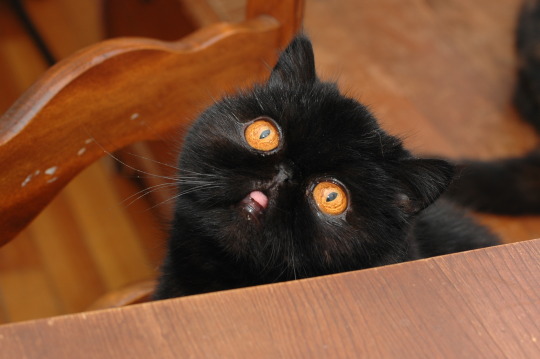Photo






CRYPTOZOOLOGY
[noun]
the study of evidence tending to substantiate the existence of, or the search for, creatures whose reported existence is unproved, as the Abominable Snowman or the Loch Ness monster. The discipline is traditionally viewed as a pseudoscience.
Etymology: from Greek kryptos, “hidden” + zoology, “study of animals”, literally, “study of hidden animals”.
[Rovina Cai]
2K notes
·
View notes
Photo





A John Bauer inspired photo shoot with Louvrianne. Photography: Jakob Sandell Model: Louvrianne
3K notes
·
View notes
Photo

Yesterday’s (blurry) birthday outfit, wearing my Pippi Longstocking halter JSK.
138 notes
·
View notes
Photo



My Bambi de la forêt secrete JSK just arrived!
123 notes
·
View notes
Photo

Ship noise makes cuttlefish change color
The blare of human noise causes birds to pipe down and frogs to breed less frequently. Now, scientists have found a humanmade sound that has a far more colorful effect: The boom of a ship’s engine makes common cuttlefish (Sepia officinalis) change the complex swirls of skin hues, stripes, and spots that they use for camouflage and communication. Like other cephalopods such as octopus and squid, cuttlefish rely on visual and tactile signals to communicate; there’s been little evidence so far to suggest they perceive—or respond to—sound. But when researchers placed a loudspeaker near cuttlefish tanks and played the sound of an underwater engine, the animals swam more and changed colors more often. They also raised their first pair of arms, which are used to sense water movements, more frequently, the team reports in this month’s issue of The American Naturalist.
474 notes
·
View notes
Photo


Costume for Judi Dench as Irina Arkadina in “The Seagull” by Chekhov
1994
Fotini Dimou
V&A
3K notes
·
View notes
Photo

Mind-controlled prosthetic arms that work in daily life are now a reality
In January 2013 a Swedish arm amputee was the first person in the world to receive a prosthesis with a direct connection to bone, nerves and muscles. An article about this achievement and its long-term stability will now be published in the Science Translational Medicine journal.
“Going beyond the lab to allow the patient to face real-world challenges is the main contribution of this work,” says Max Ortiz Catalan, research scientist at Chalmers University of Technology and leading author of the publication.
“We have used osseointegration to create a long-term stable fusion between man and machine, where we have integrated them at different levels. The artificial arm is directly attached to the skeleton, thus providing mechanical stability. Then the human’s biological control system, that is nerves and muscles, is also interfaced to the machine’s control system via neuromuscular electrodes. This creates an intimate union between the body and the machine; between biology and mechatronics.”
The direct skeletal attachment is created by what is known as osseointegration, a technology in limb prostheses pioneered by associate professor Rickard Brånemark and his colleagues at Sahlgrenska University Hospital. Rickard Brånemark led the surgical implantation and collaborated closely with Max Ortiz Catalan and Professor Bo Håkansson at Chalmers University of Technology on this project.
The patient’s arm was amputated over ten years ago. Before the surgery, his prosthesis was controlled via electrodes placed over the skin. Robotic prostheses can be very advanced, but such a control system makes them unreliable and limits their functionality, and patients commonly reject them as a result.
Now, the patient has been given a control system that is directly connected to his own. He has a physically challenging job as a truck driver in northern Sweden, and since the surgery he has experienced that he can cope with all the situations he faces; everything from clamping his trailer load and operating machinery, to unpacking eggs and tying his children’s skates, regardless of the environmental conditions (read more about the benefits of the new technology below).
The patient is also one of the first in the world to take part in an effort to achieve long-term sensation via the prosthesis. Because the implant is a bidirectional interface, it can also be used to send signals in the opposite direction – from the prosthetic arm to the brain. This is the researchers’ next step, to clinically implement their findings on sensory feedback.
“Reliable communication between the prosthesis and the body has been the missing link for the clinical implementation of neural control and sensory feedback, and this is now in place,” says Max Ortiz Catalan. “So far we have shown that the patient has a long-term stable ability to perceive touch in different locations in the missing hand. Intuitive sensory feedback and control are crucial for interacting with the environment, for example to reliably hold an object despite disturbances or uncertainty. Today, no patient walks around with a prosthesis that provides such information, but we are working towards changing that in the very short term.”
The researchers plan to treat more patients with the novel technology later this year.
“We see this technology as an important step towards more natural control of artificial limbs,” says Max Ortiz Catalan. “It is the missing link for allowing sophisticated neural interfaces to control sophisticated prostheses. So far, this has only been possible in short experiments within controlled environments.”
390 notes
·
View notes
Photo

★10月11日!ロリータ新着良品放出★商品公開第二弾★|closetchild横浜店blog
3 notes
·
View notes


























